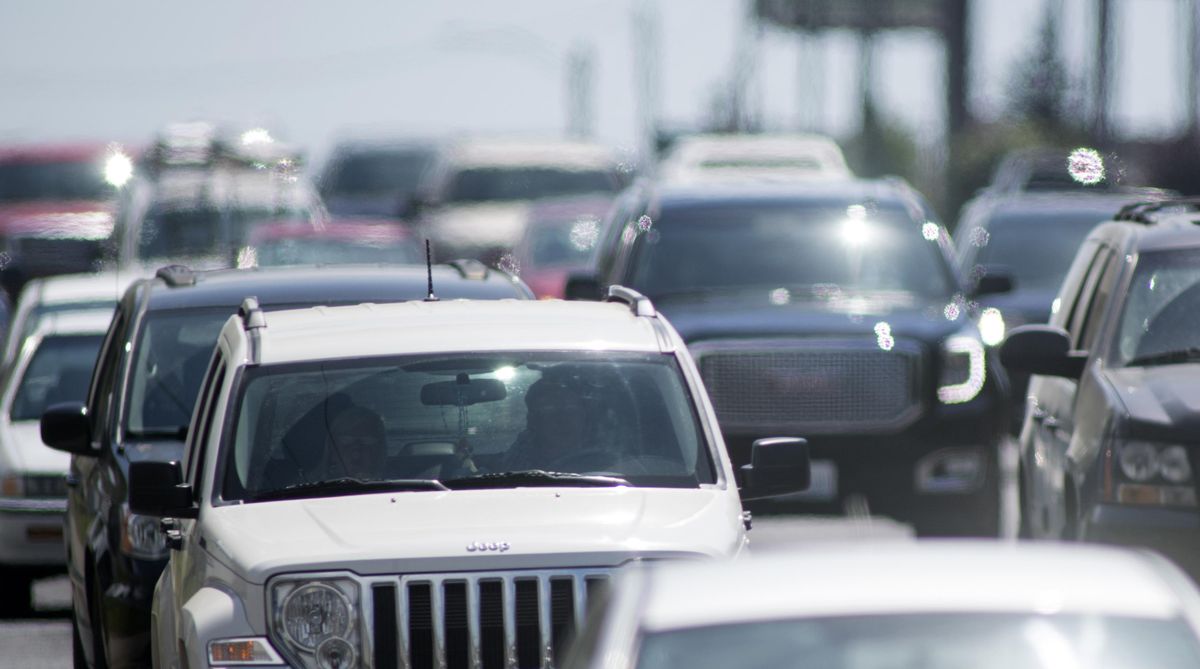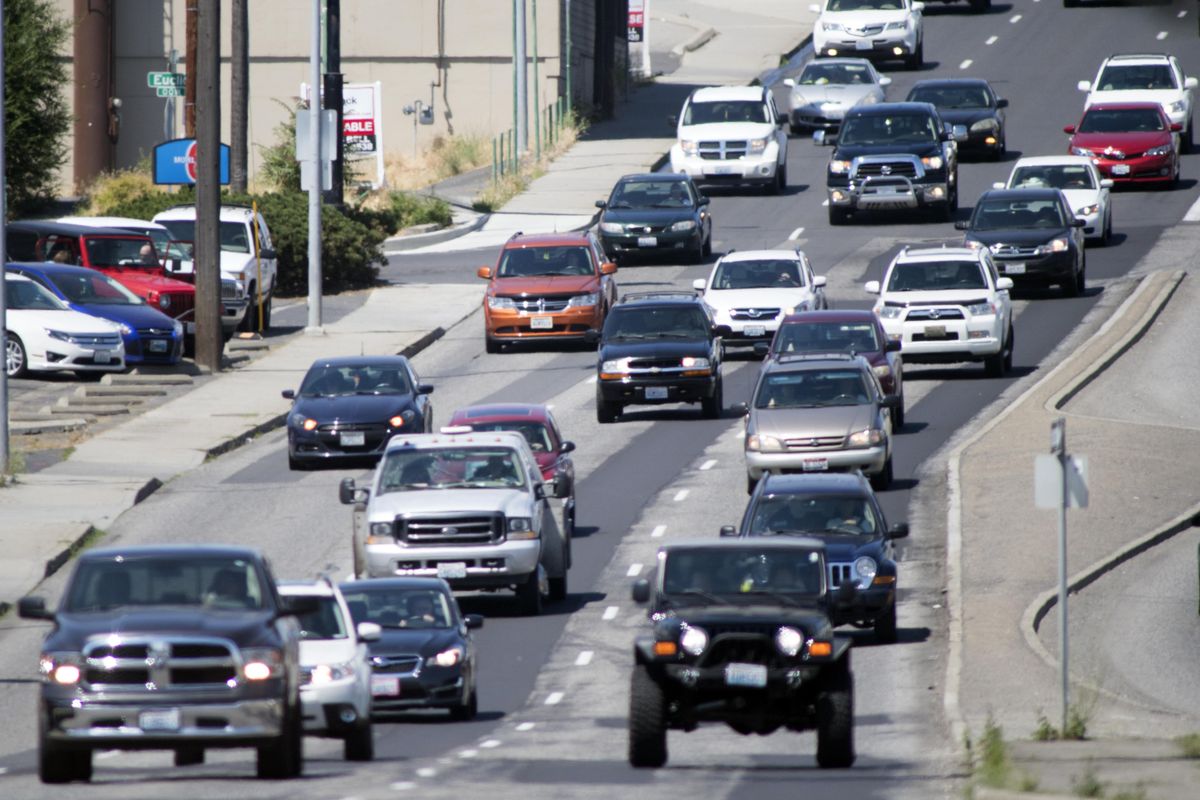Ozone pollution persists in Spokane
Cars and trucks, and the fumes from the gasoline that powers most of them, contribute to the formation of ozone in the local atmosphere, expecially when the temperatures soar into the 90s in the summer time. Ozone is component of unhealthy air and can cause lung irritation. Photographed on Division Street Friday, July 7, 2017. (Jesse Tinsley / The Spokesman-Review)Buy a print of this photo
Wood smoke, dust and carbon monoxide aren’t the only pollutants causing problems in Spokane.
Ozone levels rise during the hot days of summer, at times reaching unhealthy levels.
Officials at the Spokane Regional Clean Air Agency said the problem of ozone is largely related to gasoline-powered vehicles and tools.
On Wednesday, the ozone measuring station at Green Bluff reported that ozone had gone into a level considered unhealthy for people with lung and heart conditions.
That was among the highest readings so far this season.
The Green Bluff sensors placed the ozone level at 103 on the air quality index. That translated into ozone pollution of 0.074 parts per million in the air.
At that concentration, ozone will irritate the lungs and airways and potentially cause damage over time.
While the spike on Wednesday only lasted a short time, medical studies show that eight hours of exposure to that much ozone will cause health problems.
Not only are persons with lung and heart problems susceptible, but so are children and active adults who are running, riding or working out when ozone levels are on the rise.
Lisa Woodard, spokeswoman for the clean air agency, said one doctor became known in air pollution circles for saying that breathing too much ozone is like giving your lungs a sunburn.
“It inflames the lining of the lungs,” she said.
According to the American Lung Association, “Ozone aggressively attacks lung tissue by reacting chemically with it.”
Ozone is known to cause long-term health effects and may increase the risk of early death.
The tiny molecules are not easily scrubbed by the human body from the respiratory tract.
Ozone in Spokane rises during warm sunny days. In concentrations, it gives off an odor like chlorine that some people may smell.
Near the ground, it is considered a serious pollutant and a component of what is called smog.
In the upper atmosphere, an ozone layer provides a protective shield from the sun’s ultraviolet radiation because it absorbs some of the incoming radiation.
Ozone forms in the lower atmosphere as a chemical reaction between volatile vapors from gasoline, solvents and oxides of nitrogen.
Heat and sunlight accelerate the reaction.
As a result, ozone pollution typically peaks in late afternoon this time of year.
The state estimates that Spokane produces 32,400 tons of volatile organic compounds and 16,100 tons of nitrogen oxides every year.
Ozone starts forming in the urban area where traffic is heavy and industry is generating emissions.
Then it drifts across the Spokane “air shed,” depending on the wind.
The two ozone measuring stations are located outside the urban area at Green Bluff and Turnbull.
Turnbull saw a spike in ozone on Friday.
County Commissioner Al French, the current chair of the regional clean air board, said the dispersement of pollutants means that most parts of the county may have dirty air at times, and the pollution may drift toward Stateline.
“Two things we have no control over is temperature and wind,” French said.
Some of the pollution comes from an increase in population, he said.
When it comes to ozone, average levels have been staying relatively level over the past 12 years.
That may be due to improvements in clean-air technology; more efficient automobiles; and gasoline vapor recovery systems.
Industry, which is responsible for about 5 percent of ozone, has gone through dramatic changes in energy use and conservation, said April Westby, of the clean air agency.
“The technology that is out there is a lot cleaner,” she said.
More efficient boilers and heat recovery systems are a major reason.
“If you burn less gas you have fewer emissions,” Westby said.
Kaiser Aluminum has upgraded its technology and reduced pollution, Westby said.
In another example, BNSF Railway has installed auxiliary power units on locomotives to reduce emissions while idling.
Huntwood Industries, which uses solvent-based coatings for furniture, has installed an elaborate vapor recovery system in its production lines, Westby said.
Some 200 businesses in Spokane make money by painting. Many of them have switched to acrylic and water soluble paints, but wood furniture still needs a solvent-based coating.
Woodard said the clean air board wants to prevent Spokane from becoming a nonattainment area for ozone, which it has done so far, to avoid federal sanctions that would cost the region money.
Public education is a major way to stem increases in ozone, she said.
Getting people to drive fewer miles, ride transit, ride bikes or carpool is one way.
Drivers should refuel in the evening or at night to prevent gas fumes from getting into the air during peak temperatures.
Also, fueling power equipment and running when it is late or cool prevents precursors of ozone from getting into the air. People should mow when it is cool, officials said.
Gas stations are the largest single source of ozone-producing vapors.
According to clean air data, there are 173 registered gas stations in the Spokane area.
Of those, only 10 stations have advanced vapor recovery systems, which use a rubber sleeve on the pump nozzle to collect fuel vapor coming out of the tank as it is being refilled.
Woodard said that refueling should stop when the nozzle clicks off. Topping the tank after that causes a release of vapors.
Costco, Safeway, Fred Meyer and the Petro center in Airway Heights are among the businesses that have voluntarily installed the advanced vapor recovery.
Since 2006, virtually all vehicles have on-board vapor recovery systems, which has helped stem ozone pollution, said Joe Southwell, an engineer with the clean air agency.
Other tips for reducing ozone include keeping tire air pressure up; shutting off the engine rather than idling it; making sure gasoline containers are tightly sealed; using products at home that have zero or low volatile organic compounds; switching to electric or manual lawn equipment; and refueling vehicles at stations with advanced vapor recovery.

